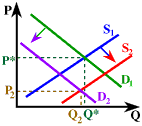

 4. Since we know that price falls but quantity remains relatively
unchanged, supply had to increase and demand had to decrease. Choice
(b) states that the manufacturing costs of cassette tapes have
fallen which would lead to an increase in the supply; and the price
of CDs (a substitute for prerecorded cassettes) has fallen, leading
to a decrease in demand.
4. Since we know that price falls but quantity remains relatively
unchanged, supply had to increase and demand had to decrease. Choice
(b) states that the manufacturing costs of cassette tapes have
fallen which would lead to an increase in the supply; and the price
of CDs (a substitute for prerecorded cassettes) has fallen, leading
to a decrease in demand.
Let's consider the other choices:
- Manufacturing costs of cassette tapes have fallen and the price
of compact disks (CDs) has risen. This would lead to an increase in supply (which is correct) but an
increase in demand as well. These two together would cause quantity
to rise unambiguously.
- Manufacturing costs of cassette tapes have fallen and the price
of CDs has fallen.
- Manufacturing costs of cassette tapes have risen and the price
of CDs has fallen. This would reduce supply and reduce demand, causing an unambiguous
reduction in quantity.
- Manufacturing costs of cassette tapes have risen and the price
of CDs has risen. This would reduce supply and increase demand, causing an unambiguous
increase in price.
- Manufacturing costs of cassette tapes have fallen and the price
of tape decks has fallen. This would lead to an increase in supply (which is correct), but an
increase in demand (since tape decks are complementary goods for
prerecorded cassettes) as well. These two together would cause the
quantity to rise unambiguously.


Copyright © 1995-2005 OnLineTexts.com, Inc. - All Rights Reserved
 4. Since we know that price falls but quantity remains relatively
unchanged, supply had to increase and demand had to decrease. Choice
(b) states that the manufacturing costs of cassette tapes have
fallen which would lead to an increase in the supply; and the price
of CDs (a substitute for prerecorded cassettes) has fallen, leading
to a decrease in demand.
4. Since we know that price falls but quantity remains relatively
unchanged, supply had to increase and demand had to decrease. Choice
(b) states that the manufacturing costs of cassette tapes have
fallen which would lead to an increase in the supply; and the price
of CDs (a substitute for prerecorded cassettes) has fallen, leading
to a decrease in demand. 
